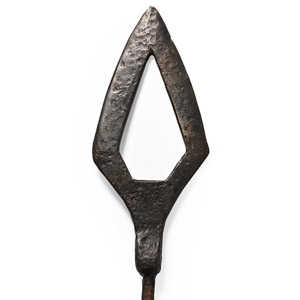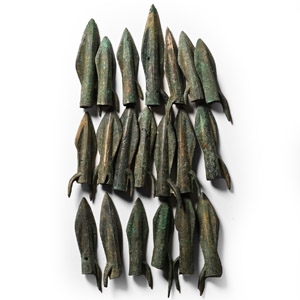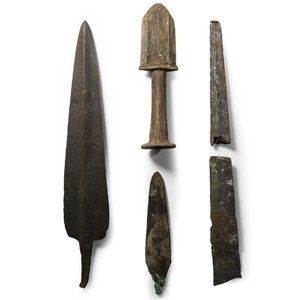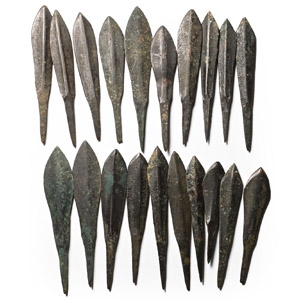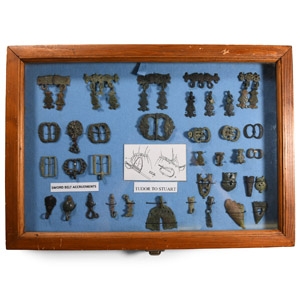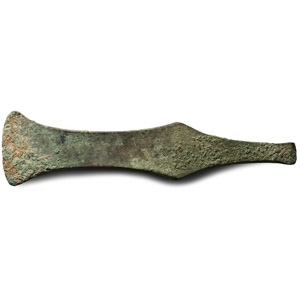Home > Auctions > 3 - 8 September 2024
Ancient Art, Antiquities, Natural History & Coins
Auction Highlights:
Ex London, UK, collection, 1990s.
Cf. Khorasani, M.M., Arms and Armour from Iran. The Bronze Age to the End of the Qajar Period, Tübingen, 2006, item 466, for one of the types.
The arrowhead of type IV according to Khorasani classification (arrowheads with jet like wings) is very interesting and rare. Similar arrowheads, often found in the Marlik excavations, looked like a stylised flying bird, such as a swallow. They have rounded terminals of the stretched-out wings. The rib on the blade thickens towards the point.
Acquired on the French art market.
From the private collection of a Buckinghamshire, UK, gentleman.
The central void was included to allow cloth soaked in tallow to be bound around the arrowhead; this was ignited before shooting.
Acquired 1980-2015.
Ex Abelita family collection.
Cf. Gorelik, M., Weapons of Ancient East, IV millennium BC-IV century BC, Saint Petersburg, 2003, in Russian, see pl.XXXIII, no.82, from Tepe Hissar; Gernez, G., L’armament en métal au Proche et Moyen-Orient: des origines a 1750 av. J.C., Paris, 2007, p.301, fig.2.88, subtype L2.B.b.
The specimen belongs to the category of tripartite spears with long pointed biconvex blade and single bevelled tang. They seem to be a Mesopotamian and Susian (Elamite) variant, and this type also includes decorated blades, like the spear from Tello with the inscription 'King of Kish'.
Acquired 1990s-early 2000s.
East Anglian private collection.
Cf. Hjardar, K. & Vike, V., Vikings at war, Oxford-Philadelphia, 2016, p.163, for the typology of eastern axes similar to the Viking bearded specimen in our group.
Slavic battle-axes also came into use in Scandinavia, especially in the Eastern part of Gotland, Denmark and Sweden. There were narrow-bladed types, described as being very light. Another characteristic of some of the Eastern axes was an extra long hammer or more rarely a secondary blade protruding from the back of axehead.
UK private collection before 2000.
Acquired on the UK art market.
Property of a London gentleman.
Cf. Gorelik, M., Weapons of Ancient East, IV millennium BC-IV century BC, Saint Petersburg, 2003, in Russian, for similar arrowheads from Eurasian sites (plate XLIV, nos.19,31,32,36,37,38,39,51,71).
In the Greek warfare archery mainly employed Scythians and Cretans for the longer-ranks. Both used composite bows made of wood, horn, bone and sinew. This explains the great range of Scythian arrowheads also found on the Greek sites.
From a collection acquired on the UK art market from various auction houses and collections mostly before 2000.
From an important Cambridgeshire estate; thence by descent.
From a specialist collection of militaria, London, UK, collected 1990s onwards.
Accompanied by an academic paper by military specialist Dr Raffaele D'Amato, dated 15 July 2019 and titled 'Eastern Roman Empire - Greek Fire Bomb or Hand Grenade (μεσαίον kακάβιον) 9th-11th century AD'.
Cf. Arendt, W. I., Granaten des 13-14. Jahrhunderts, die an der Wolga gefunden sind, Zeitschrift fur Historische Waffen-und Kostumkunde, 11 (1926-8), p.42; cf. Arendt, W., Die Spharisch-konischen Gefäße aus Gebranntem Ton, ibid; cf. Ayalon, D., Gunpowder and Firearms in the Mamluk Kingdom, London, 1956, p.16.
Apart from the use of siphons or manual flame-throwers called cheirosiphona, special corps of Roman soldiers employed terracotta grenades, in the form of small jars, abundantly evidenced in archaeological excavations. They were called μεσαία kακαβιά or κυτροκακάβια where the former had a bulbous shape and the latter a more cylindrical form.
UK private collection before 2000.
Acquired on the UK art market.
Property of a London gentleman.
Cf. for similar arrow-points Gorelik, M., Weapons of Ancient East, IV millennium BC-IV century BC, Saint Petersburg, 2003, in Russian, (plate XLIII, nos.26-27, 92-93).
These kind of arrowheads were typical of the Old Babylonian Empire. The shoulders were pronounced and the arrowhead had a rectangular-section tapering tang. This simple form was popular throughout and show comparative common finds in the Bible Lands.
From the collection of the famous author, writer and speaker, Gordon Bailey, Essex, UK; formed since 1968.
Bailey, G., Detector Finds, Witham, 1992, p.7 (double-loop buckle frame).
From a collection of a gentleman, acquired on the London art market in the 1990s.
From a military inspired collection formed from the 1990s.
Accompanied by an academic paper by military specialist Dr Raffaele D'Amato, dated 15 July 2019 and titled 'Eastern Roman Empire - Greek Fire Bomb or Hand Grenade (μεσαίον kακάβιον) 9th-11th century AD'.
Cf. Arendt, W. I., Granaten des 13-14. Jahrhunderts, die an der Wolga gefunden sind, Zeitschrift fur Historische Waffen-und Kostumkunde, 11 (1926-8), p.42; cf. Arendt, W., Die Spharisch-konischen Gefäße aus Gebranntem Ton, ibid; cf. Ayalon, D., Gunpowder and Firearms in the Mamluk Kingdom, London, 1956, p.16.
Apart from the use of siphons or manual flame-throwers called cheirosiphona, special corps of Roman soldiers employed terracotta grenades, in the form of small jars, abundantly evidenced in archaeological excavations. They were called μεσαία kακαβιά or κυτροκακάβια where the former had a bulbous shape and the latter a more cylindrical form.
Acquired 1980-2015.
Ex Abelita family collection.
Cf. Schmidt, P.K. & Burgess, C.B., The Axes of Scotland and Northern England, Prähistorische Bronzefunde, Ab. IX, vol. 7, Munich, 1981, p.60, for similar examples.
1153 - 1164 of 3369 LOTS

.jpg)

.jpg)
.jpg)
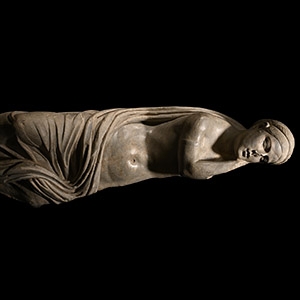
.jpg)
.jpg)


